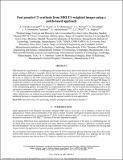Fast pseudo-CT synthesis from MRI T1-weighted images using a patch-based approach
Author(s)
Alcain, E.; Montemayor, A. S.; Rozenholc, Y.; Lopez Herraiz, Joaquin; Hernandez-Tamames, J. A.; Adalsteinsson, Elfar; Wald, Lawrence; Malpica, N.; Torrado-Carvajal, A.; ... Show more Show less
DownloadFast pseudo-CT.pdf (4.586Mb)
PUBLISHER_POLICY
Publisher Policy
Article is made available in accordance with the publisher's policy and may be subject to US copyright law. Please refer to the publisher's site for terms of use.
Terms of use
Metadata
Show full item recordAbstract
MRI-based bone segmentation is a challenging task because bone tissue and air both present low signal intensity on MR images, making it difficult to accurately delimit the bone boundaries. However, estimating bone from MRI images may allow decreasing patient ionization by removing the need of patient-specific CT acquisition in several applications. In this work, we propose a fast GPU-based pseudo-CT generation from a patient-specific MRI T1-weighted image using a group-wise patch-based approach and a limited MRI and CT atlas dictionary. For every voxel in the input MR image, we compute the similarity of the patch containing that voxel with the patches of all MR images in the database, which lie in a certain anatomical neighborhood. The pseudo-CT is obtained as a local weighted linear combination of the CT values of the corresponding patches. The algorithm was implemented in a GPU. The use of patch-based techniques allows a fast and accurate estimation of the pseudo-CT from MR T1-weighted images, with a similar accuracy as the patient-specific CT. The experimental normalized cross correlation reaches 0.9324±0.0048 for an atlas with 10 datasets. The high NCC values indicate how our method can accurately approximate the patient-specific CT. The GPU implementation led to a substantial decrease in computational time making the approach suitable for real applications.
Date issued
2015-11Department
Madrid-MIT M+Visión Consortium; Harvard-MIT Program in Health Sciences and Technology; Massachusetts Institute of Technology. Research Laboratory of ElectronicsJournal
Proceedings of SPIE--the Society of Photo-Optical Instrumentation Engineers
Publisher
Society of Photo-Optical Instrumentation Engineers (SPIE)
Citation
Torrado-Carvajal, A. et al. “Fast Pseudo-CT Synthesis from MRI T1-Weighted Images Using a Patch-Based Approach.” Proceedings of SPIE, 11th International Symposium on Medical Information Processing and Analysis, Cuenca, Ecuador, 17, November, 2015. Vol. 9681. Edited by Eduardo Romero et al., SPIE, 2015. n.p. © 2015 SPIE
Version: Final published version
ISSN
0277-786X
1996-756X